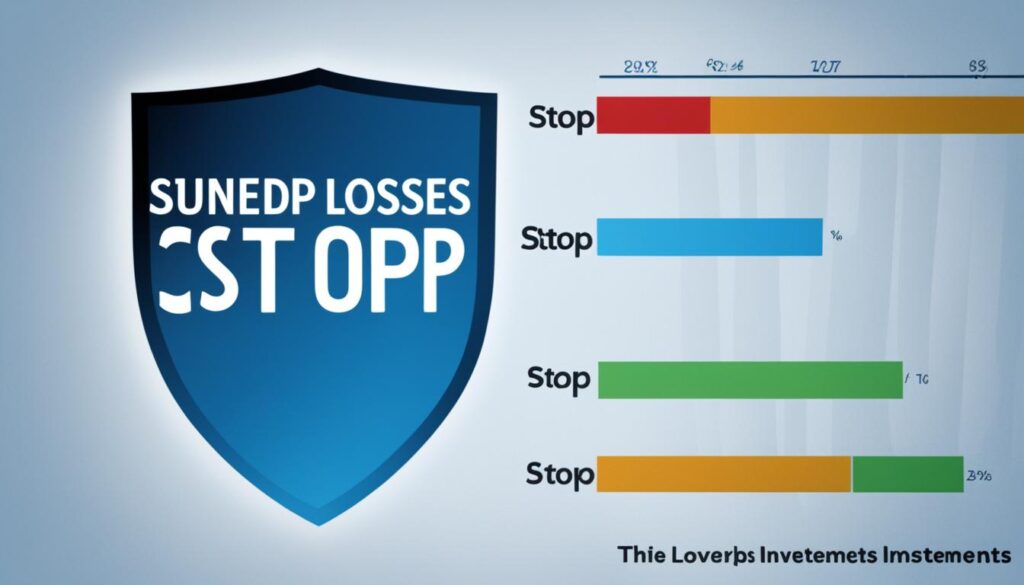Warren Buffett, a famous investor, always says not to lose money. However, avoiding all risks isn’t possible. But, you can use smart strategies to keep your online investments safe. This piece talks about six ways to do that.

Key Takeaways:
- Using smart strategies is key to keeping your online investments safe.
- Spread your investments to lower the risk of putting too much in one place.
- Adding assets that don’t follow market trends can soften the blow of ups and downs.
- Options like put options and stop losses help lock in profits and cut losses when the market drops.
- Stocks that pay dividends can give you a regular income and make your portfolio less shaky.
Diversification: Spreading Your Investments to Minimize Risk
Diversification is a vital strategy in managing risks. It involves spreading investments across various asset classes and firms. This step reduces risks tied to a specific company or sector. A diverse portfolio shields your investments in difficult market times.
To build a solid investment portfolio, diversification is key. It means not focusing all investments in one area. This strategy includes assets like stocks, bonds, real estate, and commodities. By doing so, you lower the effect of one bad investment on your whole portfolio.
Different asset classes often react differently across market conditions. For instance, in economic slumps, stocks might lose value, while bonds could stay stable or grow. Having both stocks and bonds can balance gains and losses.
In each asset class, it’s wise to invest in various companies. This prevents heavy losses tied to one firm’s downturn. By distributing your investments, the risk linked to single companies decreases.
Imagine a portfolio with stocks only in one company, which then struggles financially. Your portfolio would suffer significantly. But, a diversified portfolio with investments in different companies lessens the effect of one’s downturn. This reduces your overall risk.
Benefits of Diversification
“Diversification is the only free lunch in finance.” – Harry Markowitz
Diversification brings several advantages for minimizing risk and enhancing your portfolio:
- Reduced Risk: Spreading your investments over various asset classes and companies lessens the effect of poor performers. This is crucial for protection in market lows or industry troubles.
- Enhanced Stability: It adds stability to your portfolio. When some investments lose value, others might do well. This helps keep your portfolio’s overall performance balanced.
- Potential for Higher Returns: It also may lead to better returns. Investing across different areas allows you to exploit growth in various sectors.
However, remember diversification doesn’t ensure profits or shield against all losses. Market changes affect all investments, diversified or not. So, regularly check and adjust your portfolio to keep it in line with your goals and risk willingness.
Non-Correlating Assets: Adding Variety to Your Portfolio
Diversifying your investment portfolio is crucial to manage risk and volatility. Including non-correlating assets is an effective strategy. Assets like bonds, commodities, currencies, and real estate usually move differently than stocks. This difference adds a layer of risk reduction.
Adding these assets can lessen the impact of market ups and downs. When stocks fall, non-correlating assets may not, acting as a safety net. This strategy makes your investment approach more balanced and potentially safer.
However, the relationship between assets can shift over time. Choosing the right non-correlating assets requires research and maybe some advice from a financial advisor. They can help you pick a variety that aims to lower your risk.

Adding non-correlating assets to your portfolio means more diversification. This approach can make your investments steadier and might improve returns over time. Diversification doesn’t remove risk completely. It spreads your investments to reduce potential losses.
Put Options: Protecting Your Profits
Protecting your profits is crucial in online investing. The use of put options is a key strategy for risk management. They offer downside protection in the stock market, helping investors hedge against potential losses.
What exactly are put options? They allow investors to sell a stock at a set price, called the strike price, within a certain period. If the stock’s price falls below the strike price, investors can sell at the higher price. This minimizes their losses.
Put options are especially useful during market ups and downs or when there’s a risk of decline. They work like insurance, protecting against price drops. By buying put options, you can secure your profits and reduce potential losses in your portfolio.
Consider this example: You own shares in XYZ Company, currently worth $50 per share. You’re worried the price may drop due to various factors.
You buy put options for $45 per share, good for three months. This means you can sell your shares at $45 during this time.
If the stock falls below $45, you can use your put option. This lets you sell at the higher strike price, cutting your losses. Such protection helps you keep your profits safe during market swings.
Remember, put options aren’t free. They come with an option premium. This fee depends on the stock’s volatility, time until expiration, and the strike price. It’s important to weigh these factors and decide if the put option’s cost fits your risk management plan.
Quote: “Put options provide investors with a valuable tool for protecting their profits and managing risk in the stock market.” – John Anderson, Financial Advisor
Put options offer a way to shield your profits and manage risks in online investments. They are a strong strategy for investors wanting downside protection. But, it’s essential to fully grasp how they work and what they cost before using them in your strategy.

Stop Losses: Setting Limits to Minimize Losses
Stop losses are key in managing risk in online investing. They let investors set price levels for automatic selling. This limits potential losses. Especially during market swings, stop losses are crucial.
Stop losses act as a safety net for your investments. They help you keep your capital safe when the market changes. Setting the right stop loss levels provides discipline and prevents hasty decisions in tough times.
Using stop losses helps manage investment risks. It keeps losses small and manageable. This way, your overall investment stays safer.
Market ups and downs bring risks to online investing. Stop losses help you handle these risks. They protect your investment by setting loss limits. This control is vital for stability.
Stop losses also fit well with risk management principles. They show you’re proactive about minimizing risks. This method focuses on keeping your capital safe for long-term growth.
Example: Setting Stop Losses
Imagine an investor buys shares of Company XYZ at $50 each. To avoid major losses from market changes, they set a stop loss at $45. If the price drops to $45 or less, the shares sell off. This limits the loss to $5 per share.
Here’s a table showing how different stop loss settings affect losses:
| Stop Loss Level | Potential Loss per Share |
|---|---|
| $45 | $5 |
| $40 | $10 |
| $35 | $15 |
| $30 | $20 |
In our example, the stop loss level decides the loss per share. A $45 stop loss cuts losses to $5 per share. This gives some protection.
Implementing stop losses is smart in online investing. They limit losses, protect your capital, and help you handle market swings well.

Dividends: Generating Income and Reducing Volatility
Managing risk and cutting down on volatility in your portfolio is important. Dividends play a key role. They give you a steady flow of cash and help shield you from market drops. Let’s see how dividends can increase income and lower risk in stocks.
Steady Income Generation
Dividend-paying companies often have solid earnings and strong cash flow. Investing in them gives you access to ongoing income. This can support your financial aims. Dividends are a solid source of cash, giving you passive income during up and down markets.
For instance, say you have shares in ABC Corporation, known for its dependable dividends. ABC gives out dividends quarterly based on its earnings. This income adds stability and boosts your other income sources. It makes investing in such companies appealing for steady cash flow.
Risk Reduction and Portfolio Diversification
Dividends do more than generate income. They also cut down risk and help diversify your portfolio. Companies that pay regular dividends are often well-established. They have a history of thriving even in tough markets. This makes them solid investments.
Adding dividend stocks from various sectors to your portfolio can lessen risk further. This strategy spreads your investments among different companies. It softens the blow of any one stock’s poor performance. This way, you don’t risk too much on a single industry or sector.
Minimized Volatility
Stocks that give regular dividends tend to be less volatile. The ongoing income from dividends helps keep your investment’s value more stable. This acts as a safeguard during market ups and downs. Dividend payments provide a steadier return on your investment.
For example, owning shares in XYZ Corporation that pays dividends can be reassuring. If the market drops sharply, your dividends can help lessen the impact on your stock’s value. It brings a sense of steadiness in unpredictable times.
Dividends are key for earning cash, lessening risk, broadening portfolio diversity, and cutting volatility.
Choosing the right dividend-paying stocks is crucial. It can offer you reliable income and lowered risk. Dividend investing is an effective way to aim for stability and growth over the long term.

| Benefits of Dividend Investing | Risk Reduction | Income Generation | Portfolio Diversification | Volatility Minimization |
|---|---|---|---|---|
| Stable earnings and cash flow | Spreads risk across industries | Consistent and reliable income | Reduces impact of single stock performance | Helps stabilize portfolio value |
| Established companies | Buffer against market downturns | Supplemental passive income | Enhances overall diversification | Offers predictable return on investment |
Principal-Protected Notes: Preserving Capital with Guaranteed Returns
Principal-protected notes are a smart pick for investors who dislike risks. They help keep your original amount safe and promise returns. They blend fixed income and a chance to gain from the stock market, ensuring your initial investment is protected.
With these notes, you safeguard your money from market ups and downs. Yet, you still get a shot at market gains. It’s a balance between keeping your money safe and seeing it grow.
Choosing principal-protected notes means you’re into risk management and keeping your capital safe. You’re guaranteed to get your first investment back when the note matures. This protects you from losing money and offers a steady income.
Adding these notes to your investment mix can stabilize your portfolio. In unstable markets, they’re particularly useful. They offer a way to manage risk while keeping your investment strategy solid.
Benefits of Principal-Protected Notes
Principal-protected notes have many benefits:
- Capital Preservation: They come with a promise to keep your original investment safe. You won’t lose your initial capital.
- Guaranteed Returns: These notes assure a fixed income on your investment, giving you peace of mind and predictable earnings.
- Risk Mitigation: By adding these notes to your mix, you lessen the risk in your investments. This makes for a more balanced and steady approach.
- Income Generation: They often bring in a constant flow of money through interest. This is great for investors looking for regular income.
“Principal-protected notes offer a powerful combination of capital preservation and guaranteed returns for risk-averse investors.”
However, principal-protected notes aren’t without risks. Your initial capital is safe, but inflation and interest rate shifts can affect the value of your returns. So, it’s key to fully understand each note’s terms before investing.
It’s wise to talk to a financial advisor. They can help make sure these notes match your comfort with risk and financial plans.

Why Is Diversification so Important for Your Portfolio?
Diversification is key to managing investment risks. By spreading your investments across different types, you can soften the blow of market drops. This strategy cuts down unsystematic risk, adding stability in shaky markets. It’s vital for keeping your portfolio safe for the long haul.
When you diversify, you invest in various asset types like stocks, bonds, and real estate. This exposes you to different market conditions. Thus, it lowers the risk of one bad investment hurting your entire portfolio.
Diversification helps reduce unsystematic risk, which is linked to specific companies or sectors. If all your money is in one place and it falters, you could lose a lot. By diversifying, you can balance the bad with the good elsewhere.
Some assets might dip during market drops, while others could rise. Having a diverse portfolio means you’re likely to have some investments that remain steady or grow. For instance, bonds might hold steady or earn when the stock market is down, balancing stock losses.
Remember, diversification doesn’t assure profits or eliminate all risk. Yet, it is a valuable tool for protecting your investments and enhancing your portfolio’s long-term outcome.
By diversifying your investments, you can:
- Reduce the impact of market downturns on your overall portfolio value.
- Minimize unsystematic risk by spreading investments across different asset classes.
- Increase the likelihood of having investments that remain stable or even increase in value during turbulent times.
“Diversification is an essential aspect of risk management in investing.” – John Smith, Financial Advisor
Financial experts highly regard diversification. John Smith, a well-known financial advisor, says diverfyng is key to risk management and portfolio stability. By spreading your investments, you lessen market downturn impacts, aiming for lasting success.
| Asset Class | Potential Returns | Risk Level |
|---|---|---|
| Stocks | High | High |
| Bonds | Medium | Low |
| Real Estate | Medium | Medium |
| Commodities | High | High |
This table shows the risk and return of different assets. Diversifying lets you manage risk and aim for stable returns. This reduces the chance of big losses and bolsters your portfolio’s firmness.

How Do I Create an Investment Portfolio?
Creating an investment portfolio is a key step to meeting your financial dreams. Here’s a simple guide to help you start:
1. Identify and Understand Your Financial Goals
First, know your financial goals. Are you saving for retirement, a new home, or your kids’ college? Understanding these goals will help you figure out how much risk you can handle and how long you have to invest.
2. Assess Your Risk Tolerance
It’s critical to know your risk tolerance. This means knowing how much loss you can stomach. By figuring this out, you can choose the right mix of investments.
3. Conduct a Thorough Risk Assessment
Assessing risks is vital. Look at factors like market changes, economic trends, and global events. This helps you build a portfolio that can handle ups and downs.
4. Determine Asset Allocation
Deciding how to split your investments among different types, like stocks or bonds, is key. This should match your risk tolerance, investment period, and goals. The right mix can help you reach your targets.
5. Select Suitable Investments
With your asset mix set, pick specific investments. Look at their history, costs, and the team behind them. Study each investment to see if it fits your risk and return needs.
6. Regularly Monitor and Rebalance
Keeping an eye on your portfolio is important. Check how your investments are doing. Adjust them to keep your desired balance. This might mean buying or selling certain assets.

7. Seek Professional Advice if Needed
If making a portfolio seems daunting, get help from a financial advisor. They can offer advice tailored to your goals and risk level. They’ll help build a portfolio aimed at long-term growth.
Remember, managing an investment portfolio is an ongoing task. Regularly review how it’s doing. Make smart changes to stay on path towards your financial goals.
What Are the Best Ways to Avoid Risk in an Investment Portfolio?
Risk is always part of investing. But, you can manage and lessen it in your portfolio. By using risk management strategies, you can handle market changes better and make smart choices.
Diversifying is a main way to avoid risk. Spread your investments across various assets and sectors. This reduces the effect of market shifts on your portfolio. It keeps your investments from being too focused in one spot.
Asset allocation is key to managing risk. Allocate your investments across stocks, bonds, and real estate. This balanced approach can handle market ups and downs. It helps lower risk and boost returns over time.
Emotional choices can add unnecessary risk. Stay disciplined and don’t act on sudden market changes. Do a detailed risk analysis, create a safety margin, and set a loss limit. These steps help avoid emotional investing and support your long-term goals.